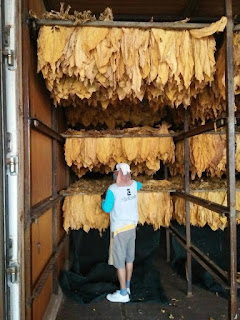สุดยอด "สารเพิ่มประสิทธิภาพ" ยุคใหม่ !!
ที่ช่วยเพิ่มประสิทธิภาพการออกฤทธิ์ของสารอื่นๆ
ที่ใช้ร่วม ให้เพิ่มฤทธิ์มากขึ้นอย่างเด็ดขาด
เสริมฤทธิ์ รวดเร็ว ฉับไว ถึงใจ
ด้วยการทำงานทั้ง..
“ลดแรงตึงผิว แผ่กระจาย เกาะติด ดูดซึม” ได้ดี
ตามคุณสมบัติ..ขั้นเทพ
ระดับ Super 4 S นั่นคือ..
1) Super-Spreader (สุดยอดการแผ่กระจาย)
2) Super-Stricker (สุดยอดการเกาะติด)
3) Super-Systemic (สุดยอดการดูดซึม)
4) Super-Surfactant (สุดยอดการลดแรงตึงผิว)
คุณสมบัติของ “ออร์ซ่า”
1) มีส่วนประกอบของสารซิลิโคน (Silicone)
ชนิดพิเศษ ที่ช่วยให้สารกำจัดวัชพืช สารกำจัด
แมลง สารกำจัดโรคพืช ฮอร์โมนพืช และปุ๋ย
เกล็ด ปุ๋ยน้ำทางใบต่างๆ จับติดใบพืชได้เด็ด
ขาด ฉับไว ภายใน 44 วินาที จึงทนทานต่อการ
ชะล้างสูง ทั้งจากฝนและจากการพ่นน้ำให้พืช
2) สามารถนำพา (Carier) สารกำจัดวัชพืช ให้
แทรกซึมเข้าสู่ใบและต้นวัชพืชได้มากและ
รวดเร็วขึ้น ทำให้วัชพืชตายเรียบ ตายสนิท
3) มีคุณสมบัติพิเศษในการเปิดปากใบ (Open
Stomata) เพื่อนำพาสารกำจัดศัตรูพืช (โรคและ
แมลงต่างๆ) แทรกซึมเข้าสู่รูของเซลล์ใบพืชได้
ดี จึงเพิ่มการดูดซึม (Systemic) สาร ทำให้
ละอองยาสัมผัสใบพืช หรือบริเวณที่เกิด
การระบาดของศัตรูพืชได้มากขึ้น
4) ช่วยลดแรงตึงผิว ทำให้สารแผ่กระจาย
(Spreader) ได้ดีขึ้นอย่างทั่วถึงทั้งใบพืช
ทำให้ใบพืชสามารถรับสารได้อย่างทั่วถึงทั้งใบ
ในเวลาที่รวดเร็ว ดังนั้น..จึงสามารถดูดซึม
เข้าไปในเนื้อเยื่อพืชได้ในระยะเวลาไม่เกิน 1-2
นาทีหลังการฉีดพ่น จึงช่วยลดการสูญเสียจาก
แสงแดด ลม และฝน
ประโยชน์ของ ออร์ซ่า (ORZA-400)
1. ช่วยย่นระยะเวลาในการดูดซึมของสารต่างๆ
(สารป้องกันกำจัดศัตรูพืช ทั้งโรค & แมลง
และวัชพืช ตลอดจนปุ๋ยและฮอร์โมนพืช) ให้
เข้าสู่พืชโดยเร็ว ในระยะเวลาไม่เกิน 1-2 นาที
2. ประหยัดต้นทุน, ลดการสูญเสียสารต่างๆ ที่ฉีด
พ่น ซึ่งโดยปกติแล้วเมื่อฉีดพ่นไป ก็จะตกหล่น
ลงบนพื้นหรือระเหยสูญเสียทิ้งไป
3. ลดค่าใช้จ่ายในด้านต่างๆ โดยเฉพาะไม่ต้อง
ฉีดบ่อยครั้ง เนื่องจากการฉีดพ่นไม่ได้ผลและ
ประสิทธิภาพที่เพียงพอ เป็นต้น
4. สามารถช่วยเพิ่มผลผลิตให้แก่ผู้ใช้ ใช้ได้กับ
พืชทุกชนิด
5. ลดความเสี่ยงจากสารเคมี ที่ต้องใช้มากเกินไป
ในการฉีดพ่นแต่ละครั้งอาทิ ยากำจัดวัชพืช
เป็นต้น
6. มีความปลอดภัยต่อผู้ใช้สูง
7. ไม่ทำลายสิ่งแวดล้อม

หมายเหตุ :
ออร์ซ่า (ORZA) ไม่ใช่เป็นเพียงสารจับใบทั่วไป ที่เป็นเพียงแค่ “ลดแรงตึงผิว” แต่ไม่ช่วยดูดซึมสารเข้าสู่ปากใบของพืช
ORZA-400 : (ออร์ซ่า-400)
Benefit Silicone modified Trisiloxane Nonionic silicone surfactantility Very low surface energy
มีคุณสมบัติช่วยในการแผ่กระจายของสาร (Super Spreading) เพิ่มอำนาจในการแทรกซึม (Penetrating) และมีความทนทานต่อการชะล้างของน้ำฝน (Rainfall)
DESCRIPTIONS :
ORZA-400 (ออร์ซ่า-400)
เป็น Modified Trisiloxane และเป็นสาร Organosilicone Surfactant ที่ช่วยในการแผ่กระจายของสารได้อย่างมีประสิทธิภาพ (Super ability of Spreading) ซึ่งสามารถลดแรงตึงผิวของน้ำให้ลดลงเหลืออยู่ที่ 20.5 mN/m เพียงใช้แค่ความเข้มข้นแค่ 0.1% (wt.)
เมื่อผสม ORZA-400 (ออร์ซ่า-400) กับสารเคมีที่ต้องการใช้แล้ว เช่น ปุ๋ย ยาฆ่าแมลง และฉีดลงบนใบของพืชนั้นจะพบว่าสามารถลดมุม (Contact angel) ของหยดน้ำที่เกาะบนใบพืชได้อย่างมีนัยสำคัญ ซึ่งส่งผลทำให้ใบเปียกได้อย่างรวดเร็ว
คุณสมบัติพิเศษ :
ของ ORZA-400 (ออร์ซ่า-400)
ที่เหนือกว่าสารจับใบชนิดอื่นๆที่เป็นแค่ Surfactant (สารลดแรงตึงผิว) แต่เพียงอย่างเดียว แต่การที่เป็นสาร Silicone ชนิดพิเศษ จะช่วยเพิ่มคุณสมบัติในการนำสารเคมีต่างๆเข้าปากใบ (Stomata) ของพืชด้วยวิธีพิเศษได้อย่างรวดเร็ว โดยผ่านทาง Stomatal Infiltration ซึ่ง Surfactant (สารลดแรงตึงผิว) อื่นๆทั่วไปไม่สามารถทำได้
นอกเหนือจากจะสามารถทำให้สารเคมีที่ใช้ในพืชสามารถดูดซึมไปใช้ได้เร็วแล้ว ยังจะมีประโยชน์ในกรณีฝนตกหรือลมแรงพัดเอาสารเคมีตกพื้นหมด
- ลดแรงตึงผิวอยู่ได้ที่ 20.5 mN/m (ค่ายิ่งน้อยยิ่งดี
จะทำให้น้ำจะแผ่กระจายในใบได้มากขึ้น ไม่เกาะ
เป็นหยด)
- สามารถทำงานได้ดีเมื่ออยู่ใน PH 6-8
- สามารถใช้กับพืชได้ทุกช่วง ไม่มีผลกับดอกและ
ผลอ่อน ของผลไม้
TECHNICAL DATA :
ค่าแรงตึงผิวที่ความเข้มข้น 0.1% [mN/m].....< 20.5 mN/m
HOW TO USE :
1 ) การผสมสารเพิ่มประสิทธิภาพในถังผสม
โดยทั่วไป สามารถเติม ORZA-400 (ออร์
ซ่า-400) 2-4 CC ลงในน้ำ 20 ลิตร เพื่อฉีด
พ่นเพื่อเสริมประสิทธิภาพในการดูดซึมของสาร
เคมีต่างๆที่ฉีดพ่น นอกจากนั้นยังสามารถลด
ปริมาณการพ่นของสารเคมีได้อีก มีอัตราส่วนที่
เหมาะสมในการผสมดังนี้ :
- สารกระตุ้นการเจริญเติบโต ( Plant promote
regulator) : 0.025%-0.05%
- สารกำจัดวัชพืช (Herbicide) : 0.025%-0.15%
- สารป้องกันและกำจัดศัตรูพืช (Pesticide) :
0.025%-0.1%
- สารกำจัดแบคทีเรีย (Bactericide) :
0.015%-0.05%
- ปุ๋ยและธาตุอาหารเสริม (Fertilizer and trace
element) : 0.015%-0.1%
•วิธีการผสม :
1)ให้ผสม ออร์ซ่า (ORZA-400) หลังจากที่ผสม
สารอื่นๆเสร็จเรียบร้อยแล้ว ในอัตราส่วน 80%
ของน้ำที่จะใช้ก่อนผสมให้เข้ากัน จากนั้นจึงเติม
น้ำให้ครบ 100% และผสมจนเป็นเนื้อเดียวกัน
ซึ่งมีข้อแนะนาในการใช้ ออร์ซ่า (ORZA-400)
คือมักจะมีการลดปริมาณของน้ำที่จะใช้ฉีดพ่น
ในปริมาณปกติ 1/2 ของปริมาณน้ำปกติ เมื่อ
เทียบกับปริมาณน้ำก่อนการใช้สารเพิ่ม
ประสิทธิภาพ (ปริมาณที่แนะนำ)
ยกตัวอย่างเช่น :
ปกติผสมปุ๋ย 10 กรัมในน้ำ 20 ลิตร สามารถฉีดผลผลิตได้ 1 ไร่ แต่ถ้าเติมสารเพิ่มประสิทธิภาพ ออร์ซ่า (ORZA-400) ลงไป สามารถผสมปุ๋ย 5 กรัมในน้ำ 10 ลิตร สามารถฉีดพ่นได้ 1 ไร่ เช่นเดียวกัน ซึ่งสามารถลดปริมาณการใช้ปุ๋ยและยา ได้อย่างมีประสิทธิภาพ และชัดเจน เพราะเวลาฉีดพ่นสารเคมีจะทำให้ใบเปียกได้เร็วมากขึ้น
และ ออร์ซ่า (ORZA-400) ยังนำพาสารเคมีเข้าสู่ปากใบพืชโดยตรงได้อีกด้วย จึงลดเวลาและปริมาณของการฉีดพ่นสารเคมีลงได้
สรุป : สารจับใบมีหลายประเภท ตั้งแต่ราคาถูกจนถึงแพง ถ้าเป็นพวกสารลดแรงตึงผิว (Surfactant) ธรรมดาทั่วไป ราคาจะไม่แพง
แต่จะสามารถทำได้เพียงแค่ลดแรงตึงผิวของน้ำได้เท่านั้น เพื่อให้เกาะอยู่บนใบได้นานขึ้นนิดหน่อย
แต่ในส่วนสารจับใบตัวที่มีประสิทธิภาพในการช่วยเรื่องของการดูดซึมของพืช ให้ได้รับสารที่พ่นมากขึ้น ก็จะมีราคาสูงขึ้นมาตามลำดับ
และด้วยคุณสมบัติพิเศษที่สำคัญของ ออร์ซ่า (ORZA-400) ที่เหนือกว่าสารจับใบทั่วไปคือ สามารถนำพาสารต่างๆ ทั้งเคมีและอินทรีย์ที่ฉีดพ่นลงไปบนใบพืชผ่านเข้าไปทางปากใบโดยตรงได้ โดยผ่านกระบวนการ Stomatal Infiltration Pathway
จากคุณสมบัติที่พิเศษตรงนี้นี่เอง ที่สามารถช่วยเพิ่มประสิทธิภาพของสารเคมีที่ใช้อยู่ได้อย่างเต็มความสามารถ เพราะว่าพืชสามารถดูดซึมไปใช้ได้อย่างเต็มที่ สามารถช่วยลดค่าปุ๋ย ค่าสารเคมี กำจัดศัตรูพืช ที่ต้องฉีดพ่นบ่อยๆ และลดค่าแรงงานในการพ่นยาได้
สอบถามเพิ่มเติม
📞084-8809595, 084-3696633
📱Line ID : @organellelife.com (อย่าลืมพิมพ์ @ ด้วยครับ)
หรือกดลิงก์ด้านล่าง แล้วเพิ่มเป็นเพื่อนใน Line@ เพื่อคุยสอบถามข้อมูลได้ครับ
https://lin.ee/nTqrAvO






























































